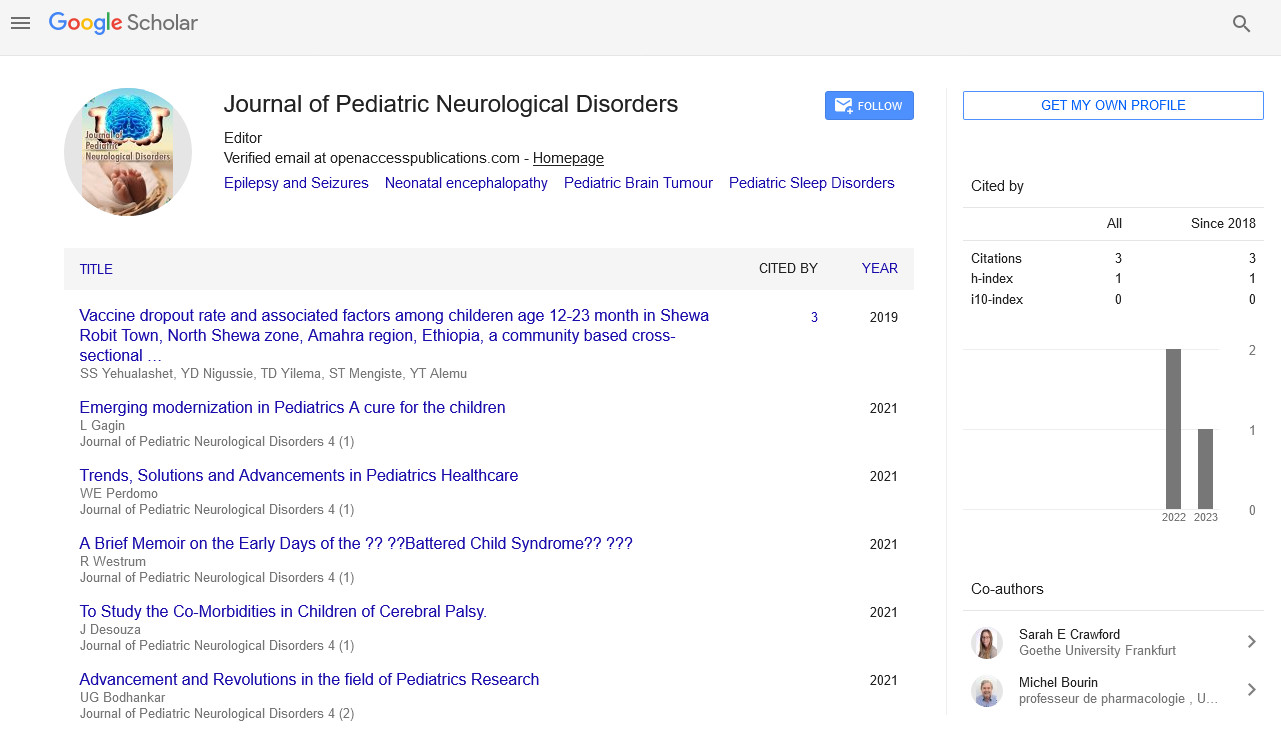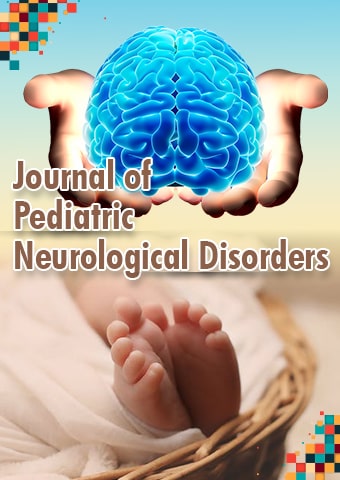Mini Review - Journal of Pediatric Neurological Disorders (2023) Volume 6, Issue 1
Sickle cell disease-related neurologic complications in children under the age of five
Mark David*
Department of Pediatrics, University of Salford, United Kingdom
Department of Pediatrics, University of Salford, United Kingdom
E-mail: david45merk@gmail.com
Received: 1-Feb-2023, Manuscript No. pnn-23-90014; Editor assigned: 2-Feb-2023, PreQC No. pnn-23-90014 (PQ); Reviewed: 15-Feb-2023, QC No. pnn-23-90014; Revised: 21-Feb-2023, Manuscript No. pnn-23-90014(R); Published: 28-Feb-2023, DOI: 10.37532/pnn.2023.6(1).12-14
Abstract
Introduction: One of the most prevalent genetic diseases worldwide, Sickle Cell Disease (SCD) affects every organ. Preventing end-organ dysfunction, particularly in the brain, in children with SCD is the most difficult aspect of medical care. Silent cerebral infarction, cerebral sinus thrombosis, epilepsy, reversible encephalopathy syndrome, and ischemic and hemorrhagic stroke are among the most common major neurologic complications in children under the age of five with SCD. Children under the age of five with SCD frequently experience migraines and recurrent headaches. The neurologic complications and the description of modifiable risk factors for children under the age of 5 will be the primary focus of this review, with a particular emphasis on the distinctions between high resource settings and low resource settings. Subjects covered: Children under the age of five and their modifiable risk factors for neurologic complications. Medical subject headings (MeSH) and keywords were used to search the PUBMED database for articles about neurologic complications in children under the age of 5. Conclusion: Silent cerebral infarction and cognitive impairment are the most common neurologic complications in children under five years old with SCD, which may be more common than currently reported.
Keywords
Sickle cell disease • Cerebral infraction • Cerebral sinus thrombosis • Epilepsy • Encephalopathy • Hemorrhagic stroke
Introduction
One of the most prevalent genetic diseases is Sickle Cell Disease (SCD), which is an autosomal recessive hemoglobinopathy. In sub-Saharan Africa, SCD has a high prevalence and is associated with high morbidity and mortality3. Sickle Cell Anemia (SCA), also known as Homozygous Beta Globin Gene Mutations (HbSS), is the most severe form of SCD. Mutations in the beta globin gene that cause hemoglobin S beta thalassemia and hemoglobin SC beta thalassemia are additional compound SCD heterozygotes [1].
This chronic, debilitating condition affects every organ system, including the brain, heart, kidney, and lung in young children. This chronic disease ultimately results in significant morbidity and a shorter lifespan for adults and children in settings with low resources and high resources, respectively. Because of improved medical care, parental anticipatory guidance for medical complications, conjugated vaccines for previously life-threatening infections, and penicillin prophylaxis, at least 98% of children in high-resource settings are now anticipated to reach adulthood [2].
Preventing end-organ dysfunction, particularly in the brain, is the next immediate challenge in high-resource settings when treating children with SCD. While improving childhood survival and preventing end-organ dysfunction are urgent requirements for children in low-resource settings. Children with SCD experience a wide range of neurologic complications, including but not limited to seizures, headaches, neurocognitive impairment, silent cerebral infarcts, and ischemic and hemorrhagic strokes, regardless of the setting in which they are diagnosed. In an unselected population of children with SCA who are not screened for abnormal Trans Cranial Doppler (TCD), the median age of an initial ischemic stroke is 6 years,6 with a prevalence of approximately 11% by the age of 18 [3].
Discussion
Major complications
Migraine: Sickle Cell Anemia (SCA), also known as Homozygous Beta Globin Gene mutations (HbSS), is the most severe form of SCD. Mutations in the beta globin gene that cause hemoglobin S beta thalassemia and hemoglobin SC beta thalassemia are additional compound SCD heterozygotes. This chronic, debilitating condition affects every organ system, including the brain, heart, kidney, and lung in young children. This chronic disease ultimately results in significant morbidity and a shorter lifespan for adults and children in settings with low resources and high resources, respectively. Recurrent headaches and migraines are common in children under five years of age in the general population and not uncommon in children with SCD, and at least 98% of children in highresource settings are now expected to reach adulthood. The prevalence of migraine in infancy and early childhood may be underestimated due to the difficulty in distinguishing a skull infarct from a headache, pseudotumor cerebri or any combination of the aforementioned. In contrast, in children with SCD, headaches can be confused with a skull infarction. The prevalence of headaches among children in the general population increases with age, ranging from 4 to 20% in preschool age and 38 to 50% in schoolage children [4].
The evaluation of young children for headaches presents a number of challenges, not the least of which is the child’s inability to describe the symptoms. It was found that recurrent abdominal pain, cyclic vomiting, episodes of fever not associated with the presence of an infectious disease process, joint pain, and other symptoms are typical signs of migraine onset in children. Reported that fatigue and yawning were the most common symptoms of a headache in children (82 percent), while nausea and vertigo were less common . An extensive medical history should be taken, followed by a physical exam and measurement of vital signs, particularly blood pressure, and a comprehensive neurologic examination that included the optic fundus [5].
Epilepsy
Feverish convulsions are typically the most common cause of seizures in young children with SCD, particularly in malaria-endemic regions.
Therefore, the expertise of an experienced pediatric neurologist will be required in order to distinguish the causes of seizures in very young children who have SCD. Meningitis, cerebral infarction, cerebral malaria, and congenital infections are among the causes of seizures in children younger than 5 years old. Although these findings have not been validated in other studies, chlamydia pneumonia in young children with SCD may potentially be associated with complications of the cerebrovascular system [6].
Cerebral Sinovenous Thrombosis
SCD subarachnoid hemorrhage typically presents with severe headache, nuchal rigidity, coma, and focal neurologic deficits, as opposed to the general population’s larger aneurysms. However, SAH is uncommon in young children with SCD, and if it is present, causes other than SCD should be considered and systematically evaluated with a neurosurgery team. Management strategies for acute hemorrhagic stroke should follow the evidence-based guidelines for children of similar age in the general population [7].
Perireversible Encephalopathy Syndrome In contrast to the larger aneurysms that are common in the general population, SCD subarachnoid hemorrhage typically presents with severe headache, nuchal rigidity, coma, and focal neurologic deficit. SAH, on the other hand, is uncommon in young children with SCD, and if it is present, a neurosurgery team should systematically evaluate potential causes other than SCD. The evidence-based guidelines for children of a similar age in the general population should be followed when implementing management strategies for acute hemorrhagic stroke [8].
Preventive Measures
A major modifiable risk factor for reducing strokes in young children with SCD is the prevention of life-threatening and serious infections. Conjugated vaccines against Streptococcus pneumoniae, Haemophilus influenzae type B, and Neisseria meningitis have significantly reduced the incidence of these infections and associated strokes in settings with high and low resources. In this age group, serious systemic illnesses like meningitis are well-known risk factors for stroke [9].
Conclusion
There may be a higher incidence of neurological complications in children with SCD younger than five years old than is currently documented. In young children with SCD, significant neurologic impairment is probably underdiagnosed due to the difficulty in diagnosing neurologic complications. Silent cerebral infarct is the most frequently reported neurologic complication in children under the age of five with SCD, with a prevalence of 26% before the child’s sixth birthday. In contrast to TCD screening, which has significantly reduced overt strokes, no primary prevention strategy for silent cerebral infarction has been developed. It is difficult to distinguish between overt stroke and other neurologic complications in very young children, such as focal neurologic deficits following a seizure or migraine. A pediatric neurologist should be consulted whenever possible for children under the age of five who present with focal neurologic deficit, migraine, or acute seizures. Preventing silent cerebral infarction and its complications, such as cognitive impairment in young children with SCD, requires research [10].
Acknowledgement
None
Conflict of Interest
None
References
- Diallo D, Tchernia G. Sickle cell disease in Africa. Current Opinion in Hematology. 9, 111-116 (2002).
- Potoka KP, Gladwin MT. Vasculopathy and pulmonary hypertension in sickle cell disease. Am J Physiol Lung Cell Mol. 308, L314-L324 (2015).
- Le PQ, Gulbis B, Dedeken L. Survival among children and adults with sickle cell disease in Belgium: Benefit from hydroxyurea treatment. Pediatr Blood Cancer. 62, 1956-1961(2015).
- Couque N, Girard D, Ducrocq R. Improvement of medical care in a cohort of newborns with sickle-cell disease in North Paris: impact of national guidelines. Br J Haematol. 173, 927-937(2016).
- Ohene Frempong K, Weiner SJ, Sleeper LA. Cerebrovascular accidents in sickle cell disease: rates and risk factors. Blood. 9, 288-294 (1998).
- Henry M, Driscoll MC, Miller M et al. Pseudotumor cerebri in children with sickle cell disease: a case series. Pediatrics.113, e265-e269 (2004).
- Watanabe M, Saito N, Nadgir RN. Craniofacial bone infarcts in sickle cell disease: clinical and radiological manifestations. J Comput Assist Tomogr.37, 91-97 (2013).
- Aromaa M, Sillanpaa ML, Rautava P et al. Childhood headache at school entry: a controlled clinical study. Neurology. 50, 1729-1736 (1998).
- Anson JA, Koshy M, Ferguson L et al. Subarachnoid hemorrhage in sickle-cell disease. J Neurosurg. 75, 552-558 (1991).
- Mayer SA, Rincon F. Treatment of intracerebral haemorrhage. Lancet Neurol. 4, 662- 672 (2005).
Indexed at, Google Scholar, Crossref
Indexed at, Google Scholar, Crossref
Indexed at, Google Scholar, Crossref
Indexed at, Google Scholar, Crossref
Indexed at, Google Scholar, Crossref
Indexed at, Google Scholar, Crossref
Indexed at, Google Scholar, Crossref
Indexed at, Google Scholar, Crossref

